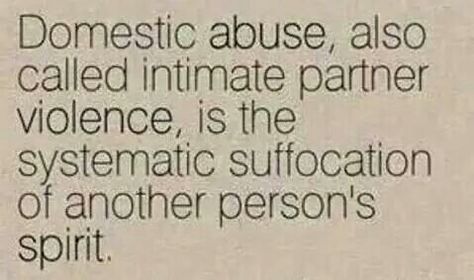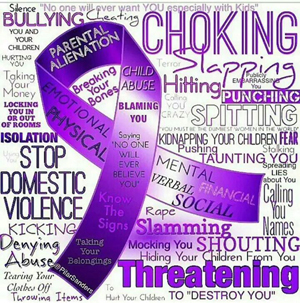Domestic violence (also known as spousal abuse, domestic abuse, family violence, intimate partner violence and relationship violence) comes in different forms:
Emotional abuse
Verbal abuse
Physical abuse
Sexual abuse
Financial abuse
Digital abuse
Power and control over the victim is the goal and abusers use fear, intimidation and humiliation to gain that power. Abuse is not a result of lack of anger management or the abuser’s lack of control over his/her actions. Abusers do have the ability to control their behavior and often do so. They don’t insult, threaten or assault everyone in their life who fails to comply to their wishes
Although all types of abuse are not considered illegal, they are all reprehensible and immoral. Many are illegal and punishable by law.
Emotional Abuse
- Constant irritability
- Constant criticism
- Manipulation
- Silent treatment
- Using children
- Harming pets
- Accusations of cheating
- Isolating victim from friends and family
- Blaming the victim
- Denying that events happened
- Depriving sleep
- Destroying property
- Making victim feels stupid, worthless, lazy
- Cheating or flirting
Verbal Abuse
- Name-calling
- Threatening
- Screaming
- Cursing
- Put-downs, insults
- Punching, slapping
- Hair-pulling, scratching
- Pushing
- Strangling
- Burning
- Biting
- Spitting
- Throwing things
Sexual Abuse
- Unwanted touching or kissing
- Forced sex when victim is unwilling, drunk, high or unconscious
- Verbal sexual insults
- Restricting access to birth control
- Treating victim as a sexual object
- Not respecting sexual limits
- Rape
Financial Abuse
- Taking paychecks
- Restricting access to bank account or bank cards
- Forbidding employment
- Running up bills victim must pay
- Refusing to pay medical costs
- Identity theft
- On-the-job harassment
Digital Abuse
- Spreading rumors
- Monitoring location or communications
- Incessant phone calls, texts or posts
- Posting or distributing embarrassing photos
- Demanding passwords
- Using spyware or GPS trackers
- Stalking
Some frightening relationship violence statistics include:
- 74 percent of Americans personally know someone who is or has been abused.
- 33 percent of American women will be victims of relationship violence; 20 percent of severe physical abuse.
- 2 percent of American men will be victims of relationship violence; 14 percent of severe physical abuse.
- 33 percent of all Texans (regardless of gender) will experience relationship violence in their lifetimes.
- 33 percent of teenagers will experience relationship violence.
- 10 percent of teenagers will experience physical abuse from a dating partner.
- Over half the women murdered in the U.S. are killed by a current or former partner.
- Battering is the leading cause of injury to American women.
Relationship violence occurs in all types of relationships regardless of income, sexual orientation, religious affiliation, age, profession, culture, relationship status and gender.
It is a conscious choice of the abuser used to gain control, not a result of intoxication or mental illness and it is NEVER the victim’s fault.
Physical effects – Victims of relationship violence may suffer from a variety of different effects in addition to those obvious from physical abuse. A few of those include:
- Chronic fatigue
- Muscle tension
- Stress
- Hypertension
- Heart disease
- GI problems
- STIs and UTIs
- Chronic pain
- Physical injury
- Broken bones
- Insomnia
Behavioral effects
- Substance Abuse (15 times more likely)
- Self-harm
- Eating disorders
- Stuttering
- Involuntary shaking
- Inability to make eye contact
Mental/emotional effects:
- PTSD
- Depression, anxiety
- Low self-worth
- Suicidal ideation
- Fear, distrust
- Shame, guilt
- Nightmares
Life changes
- Job loss, financial insecurity
- Homelessness
Risks to Life and Health
- Miscarriage
- Human trafficking
- Marital rape
- Strangulation
- Unplanned pregnancies
- Suicide, attempted suicide
- Death
Information provided by Hope’s Door New Beginning Center




